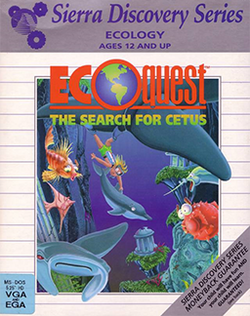Software:EcoQuest
 Cover art for The Search for Cetus | |
| Developer(s) | Sierra On-Line |
|---|---|
| Publisher(s) | Sierra On-Line Coktel Vision |
| Series | Sierra Discovery Series |
| Platform(s) | MS-DOS, Windows |
| Release |
|
| Genre(s) | Educational, Adventure |
EcoQuest is a series of two educational adventure games developed by Sierra On-Line. The original concept was developed by Sierra VP of Creative Development, Bill Davis. The authors of the series game design are Jane Jensen and Gano Haine, but Jensen was not involved in creating the second game, having moved on to the Gabriel Knight series. The game was going to be ported to Amiga and Macintosh, but those releases never came out.[1][2]
The last of Sierra's various "Quest" series, EcoQuest is designed to teach about the importance of environmental ethics. The games are considerably easier than most Sierra adventures and cannot be lost or rendered unwinnable. Both use a fully mouse-driven version of SCI1, in the manner of Space Quest IV and King's Quest VI.
The protagonist is a 10-year-old boy named Adam Greene, the son of an ecologist and an expert scuba diver.
Series
EcoQuest: The Search for Cetus
The first installment, titled The Search for Cetus, was released first on floppy disk, then on CD-ROM with full speech in 1992. Adam's attempts to help a dolphin named Delphineus that his father has rescued, takes a turn for the weirder when the dolphin starts talking. In no time flat, he's trying to seek out Cetus, the sperm whale king of Eluria, an underwater kingdom populated by marine animals. He has assistance in the form of several creatures found in the various ecosystems of the world. Aside from the considerable liberty of sentient talking and semi-anthropomorphic animals, the game is more realistic than cartoony – it needs to be, to tell about the real world's environment and pollution.
The game presents the player with practical, narrative problems to solve (typical of Sierra adventure games of the period) combined with occasional puzzle elements similar to those found in the Castle of Dr Brain. The Search for Cetus introduced the recycling symbol to Sierra's standard palette of command icons, giving the player bonus points for removing litter from the marine environment. The game introduces children ages 12 and up to marine biology and marine conservation by confronting them with the consequences of various human activities including: dumping of litter, releasing of helium-filled balloons, abandonment of fishing gear, collisions between vessels and marine mammals, spilling of oil and chemicals into the sea and the fertilization of algal blooms.
Lost Secret of the Rainforest
In Lost Secret of the Rainforest (aka EcoQuest II, though this does not appear in the game's title), the second installment in the series, Adam, now slightly older and able to speak with animals as a matter of course, explores the tropical rainforest in search of a cure of a disease afflicting the local Indigenous peoples of South America, and a way to save the rainforest from destruction. One of the game's innovations was the "Ecorder" display: a tricorder-like device Adam uses to learn about things he finds during his journey. According to Pelit, the game is somewhat harder than its predecessor and places more emphasis on the dangers of selfishness and greed, as opposed to the blight of man.
See also
- Ecology movement
- Edutainment
References
- ↑ "ACE - EcoQuest". ACE (EMAP) (54): 52. March 1992. https://archive.org/details/ace-magazine-54/page/n51.
- ↑ Witek, Vic (May 27, 1992). "EcoQuest Review". Game Bytes (2). https://archive.org/details/game-bytes-2.
External links
- EcoQuest: The Search for Cetus at MobyGames
- EcoQuest Soundtrack at QuestStudios at the Internet Archive
- EcoQuest II: Lost Secret of the Rainforest at MobyGames
- EcoQuest II Soundtrack at Sierra Music Central at the Internet Archive

